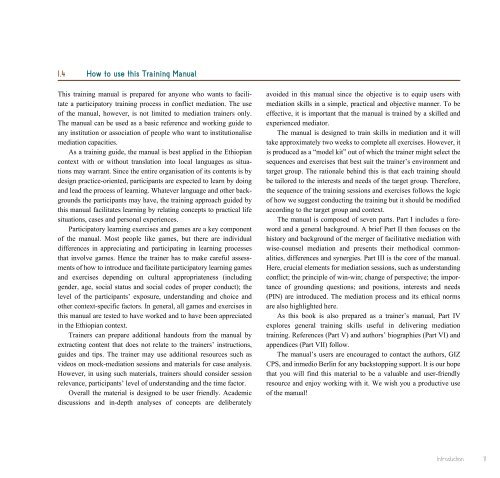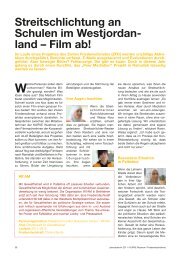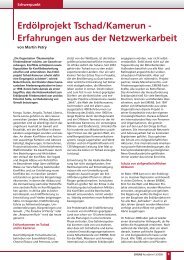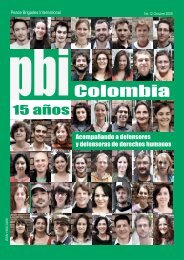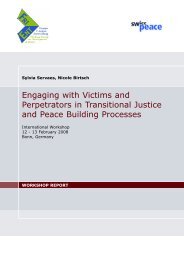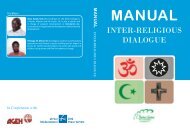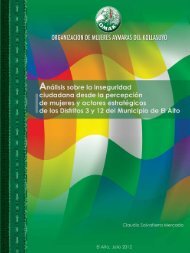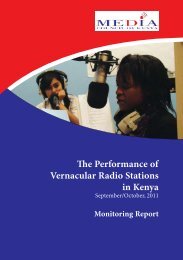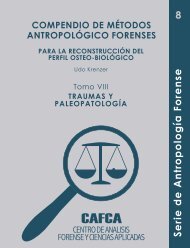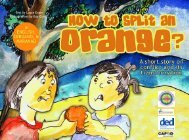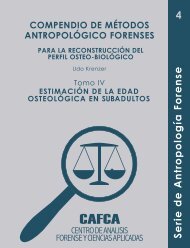Merging Ethiopian Wise-Counsel Mediation and Facilitative ...
Merging Ethiopian Wise-Counsel Mediation and Facilitative ...
Merging Ethiopian Wise-Counsel Mediation and Facilitative ...
- No tags were found...
Create successful ePaper yourself
Turn your PDF publications into a flip-book with our unique Google optimized e-Paper software.
I.4 How to use this Training ManualThis training manual is prepared for anyone who wants to facilitatea participatory training process in conflict mediation. The useof the manual, however, is not limited to mediation trainers only.The manual can be used as a basic reference <strong>and</strong> working guide toany institution or association of people who want to institutionalisemediation capacities.As a training guide, the manual is best applied in the <strong>Ethiopian</strong>context with or without translation into local languages as situationsmay warrant. Since the entire organisation of its contents is bydesign practice-oriented, participants are expected to learn by doing<strong>and</strong> lead the process of learning. Whatever language <strong>and</strong> other backgroundsthe participants may have, the training approach guided bythis manual facilitates learning by relating concepts to practical lifesituations, cases <strong>and</strong> personal experiences.Participatory learning exercises <strong>and</strong> games are a key componentof the manual. Most people like games, but there are individualdifferences in appreciating <strong>and</strong> participating in learning processesthat involve games. Hence the trainer has to make careful assessmentsof how to introduce <strong>and</strong> facilitate participatory learning games<strong>and</strong> exercises depending on cultural appropriateness (includinggender, age, social status <strong>and</strong> social codes of proper conduct); thelevel of the participants’ exposure, underst<strong>and</strong>ing <strong>and</strong> choice <strong>and</strong>other context-specific factors. In general, all games <strong>and</strong> exercises inthis manual are tested to have worked <strong>and</strong> to have been appreciatedin the <strong>Ethiopian</strong> context.Trainers can prepare additional h<strong>and</strong>outs from the manual byextracting content that does not relate to the trainers’ instructions,guides <strong>and</strong> tips. The trainer may use additional resources such asvideos on mock-mediation sessions <strong>and</strong> materials for case analysis.However, in using such materials, trainers should consider sessionrelevance, participants’ level of underst<strong>and</strong>ing <strong>and</strong> the time factor.Overall the material is designed to be user friendly. Academicdiscussions <strong>and</strong> in-depth analyses of concepts are deliberatelyavoided in this manual since the objective is to equip users withmediation skills in a simple, practical <strong>and</strong> objective manner. To beeffective, it is important that the manual is trained by a skilled <strong>and</strong>experienced mediator.The manual is designed to train skills in mediation <strong>and</strong> it willtake approximately two weeks to complete all exercises. However, itis produced as a “model kit” out of which the trainer might select thesequences <strong>and</strong> exercises that best suit the trainer’s environment <strong>and</strong>target group. The rationale behind this is that each training shouldbe tailored to the interests <strong>and</strong> needs of the target group. Therefore,the sequence of the training sessions <strong>and</strong> exercises follows the logicof how we suggest conducting the training but it should be modifiedaccording to the target group <strong>and</strong> context.The manual is composed of seven parts. Part I includes a foreword<strong>and</strong> a general background. A brief Part II then focuses on thehistory <strong>and</strong> background of the merger of facilitative mediation withwise-counsel mediation <strong>and</strong> presents their methodical commonalities,differences <strong>and</strong> synergies. Part III is the core of the manual.Here, crucial elements for mediation sessions, such as underst<strong>and</strong>ingconflict; the principle of win-win; change of perspective; the importanceof grounding questions; <strong>and</strong> positions, interests <strong>and</strong> needs(PIN) are introduced. The mediation process <strong>and</strong> its ethical normsare also highlighted here.As this book is also prepared as a trainer’s manual, Part IVexplores general training skills useful in delivering mediationtraining. References (Part V) <strong>and</strong> authors’ biographies (Part VI) <strong>and</strong>appendices (Part VII) follow.The manual’s users are encouraged to contact the authors, GIZCPS, <strong>and</strong> inmedio Berlin for any backstopping support. It is our hopethat you will find this material to be a valuable <strong>and</strong> user-friendlyresource <strong>and</strong> enjoy working with it. We wish you a productive useof the manual!Introduction11


